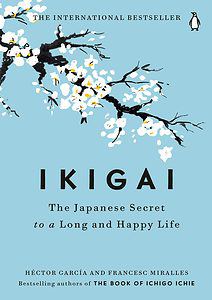
Ikigai
The Japanese Secret to a Long and Happy Life
Héctor García, Francesc Miralles
Book Summary, Notes & Highlights
A short read that I found interesting on what the habits and lifestyles of the longest-living people on earth are and what they do.
Table of Contents
🚀 The Book in 3 Sentences
- The art of living a longer life, in general
- Methods and strategies applied by people in the blue zones who live well past 100 Years old
- Finding your passion is key to living a long life.
🧠 My Thoughts
A short read that I found interesting on what the habits and lifestyles of the longest-living people on earth are and what they do.
🥷 Who Should Read It?
An interesting light read for anyone who is interested in living a long healthy lifestyle based on research. Also, how one finds their passion.
💡 How the Book Changed Me
I think the biggest takeaway for me was that life is meant for living and taking it more slowly and intentionally, also appreciating relationships and community is very important.
🪶 My Top 3 Quotes
- Focus on the journey rather than the end goal or objective.
- It’s not what happens to you, but how you react that matters.
🔥Top Actionable Take-Aways
- I am going to incorporate drinking green tea with jasmine into my daily life for health benefits.
- I have always been a believer in meditation as a means of combating stress; I’m going to try and kick start the habit again.
- Actively going to try to make non-negotiable time slots for time with friends more.
📒 Summary and Notes
I. Ikigai
The art of staying young while growing old
What is your reason for being?
According to the Japanese, everyone has an ikigai. Our ikigai is hidden deep inside each of us, and finding it requires a patient search. According to those born on Okinawa, the island with the most centenarians in the world, our ikigai is the reason we get up in the morning.
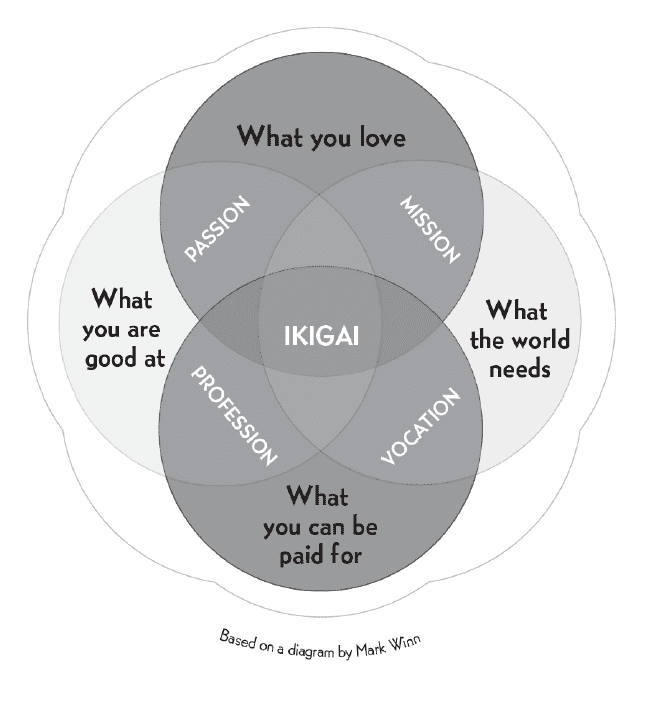
Having a clearly defined ikigai brings satisfaction, happiness, and meaning to our lives.
The Five Blue Zones
- Okinawa, Japan
- Sardinia, Italy
- Loma Linda, California
- The Nicoya Peninsula, Costa Rica
- Ikaria, Greece
According to scientists who have studied the five Blue Zones, the keys to longevity are diet, exercise, finding a purpose in life (an ikigai), and forming strong social ties—that is, having a broad circle of friends and good family relations.
The 80 percent secret
Ancient wisdom advises against eating until we are full. This is why Okinawans stop eating when they feel their stomachs reach 80 percent of their capacity, rather than overeating and wearing down their bodies with long digestive processes that accelerate cellular oxidation.
Moai: Connected for life
It is customary in Okinawa to form close bonds within local communities. A Moai is an informal group of people with common interests who look out for one another.
II. Anti-Ageing Secrets
Little things that add up to a long and happy life
Active mind, youthful body
Having a youthful mindset encourages you to lead a healthy lifestyle, which can slow down the ageing process. Just as a lack of physical exercise has negative effects on our bodies and mood, a lack of mental exercise is bad for us because it causes our neurons and neural connections to deteriorate—and, as a result, reduces our ability to react to our surroundings.
This description of a “mental workout” might sound a bit formal, but simply interacting with others—playing a game, for example—offers new stimuli and helps prevent the depression that can come with solitude.
Our neurons start to age while we are still in our twenties. This process is slowed, however, by intellectual activity, curiosity, and a desire to learn.
Dealing with new situations, learning something new every day, playing games, and interacting with other people seem to be essential anti-ageing strategies for the mind. Additionally, having a brighter attitude will lead to better mental health.
Stress: Accused of killing longevity
When a person is stressed their antibodies react the same way they react to pathogens, activating the proteins that trigger an immune response. The issue is that this answer not only stops bad agents, but it also harms healthy cells, causing them to get older faster.
The greater the stress, the greater the degenerative effect on cells.
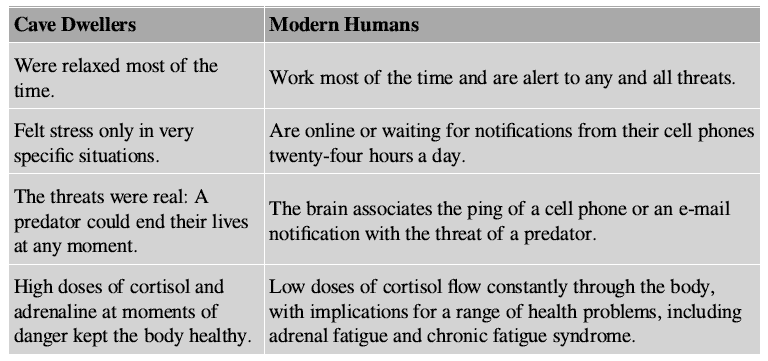
Be mindful about reducing stress
Prevention is so important in avoiding the toll that stress takes on us—and why many experts recommend practising mindfulness.
The central premise of this stress-reduction method is focusing on the self: noticing our responses, even if they are conditioned by habit, in order to be fully conscious of them. In this way, we connect with the here and now and limit thoughts that tend to spiral out of control.
A lot of sitting will age you
The connection between a lack of physical activity and the progressive distortion of telomeres in the immune system, which ages those cells and, in turn, the organism as a whole.
A models best kept secret
Get enough sleep.
Melatonin, a powerful antioxidant, is a great ally in preserving youth. It should be noted, however, that melatonin production decreases after age thirty. We can compensate for this by:
- Eating a balanced diet and getting more calcium.
- Soaking up a moderate amount of sun each day.
- Getting enough sleep.
- Avoiding stress, alcohol, tobacco, and caffeine, all of which make it harder to get a good night’s rest, depriving us of the melatonin we need.
Anti-ageing Attitude
Two key factors that centenarians have in common are a positive attitude and emotional awareness.
Having a stoic attitude- serenity in the face of a setback lowers anxiety and stress levels.
III. From Logotherapy To Ikigai
How to live longer and better by finding your purpose
What, then, does logotherapy do?
The answer is pretty clear: It helps you find reasons to live.
Logotherapy pushes patients to consciously discover their life’s purpose in order to confront their neuroses. Their quest to fulfil their destiny then motivates them to press forward, breaking the mental chains of the past and overcoming whatever obstacles they encounter along the way.
According to logotherapy, discovering one’s purpose in life helps an individual fill that existential void.
Better living through logotherapy: A few key ideas
- We don’t create the meaning of our life, as Sartre claimed—we discover it.
- We each have a unique reason for being, which can be adjusted or transformed many times over the years.
- Just as worry often brings about precisely the thing that was feared, excessive attention to a desire (or “hyper-intention”) can keep that desire from being fulfilled.
- Humour can help break negative cycles and reduce anxiety.
- We all have the capacity to do noble or terrible things. The side of the equation we end up on depends on our decisions, not on the condition in which we find ourselves.
Morita therapy
In contrast, Morita therapy focuses on teaching patients to accept their emotions without trying to control them, since their feelings will change as a result of their actions.
In addition to accepting the patient’s emotions, Morita therapy seeks to “create” new emotions on the basis of actions. According to Morita, these emotions are learned through experience and repetition.
Morita therapy is not meant to eliminate symptoms; instead, it teaches us to accept our desires, anxieties, fears, and worries, and let them go.
Your Ikigai is your existential fuel, once you find it. It’s all about finding the courage and making the effort to stay on the path.
Ikigai - finding flow in the tasks you’ve chosen to do, eating in a balanced and mindful way, doing low-intensity exercise, and learning not to give in when difficulties arise. In order to do this, you have to accept that the world—like the people who live in it—is imperfect, but that it is still full of opportunities for growth and achievement.
IV. Find Flow In Everything You Do
How to turn work and free time into spaces for growth
Going with the flow
When you are completely immersed in something when time flies by because you enjoy it, and alternatively, if you don’t enjoy something, it can feel twice as long doing that thing.
What makes us enjoy doing something so much that we forget about whatever worries we might have while we do it? When are we happiest?
These questions can help us discover our ikigai.
There is no magic recipe for finding happiness, for living according to your ikigai, but one key ingredient is the ability to reach this state of flow and, through this state, to have an “optimal experience.”
The Seven Conditions for Achieving Flow
According to researcher Owen Schaffer of DePaul University, the requirements for achieving flow are:
- Knowing what to do
- Knowing how to do it
- Knowing how well you are doing
- Knowing where to go (where navigation is involved)
- Perceiving significant challenges
- Perceiving significant skills
- Being free from distractions
Strategies to Help You Achieve the Flow State
Strategy 1: Choose a difficult task (but not too difficult!)
Schaffer’s model encourages us to take on tasks that we have a chance of completing but that are slightly outside our comfort zone.
If it’s too easy, we get bored, and if it’s too difficult, we give up and get discouraged.
The ideal is to find a middle path, something aligned with our abilities but just a bit of a stretch, so we experience it as a challenge.

Strategy 2: Have a clear, concrete objective
Video games—played in moderation—board games and sports are great ways to achieve flow because the objective tends to be very clear: Beat your rival or your own record while following a set of explicitly defined rules.
The number one complaint of employees at multinational corporations is that they don’t “communicate the team’s mission clearly,” and that, as a result, the employees don’t know what their objectives are.
We should ask ourselves questions such as: What is my objective for today’s session in the studio? How many words am I going to write today for the article coming out next month? What is my team’s mission?
Having a clear objective is important in achieving flow, but we also have to know how to leave it behind when we get down to business. Once the journey has begun, we should keep this objective in mind without obsessing over it.
Focus on the journey rather then the end goal or objective.

Strategy 3: Concentrate on a single task
When we say we’re multitasking, what we’re really doing is switching back and forth between tasks very quickly.
Concentrating on one thing at a time may be the single most important factor in achieving flow.
According to Csikszentmihalyi, in order to focus on a task, we need:
1. To be in a distraction-free environment
2. To have control over what we are doing at every moment
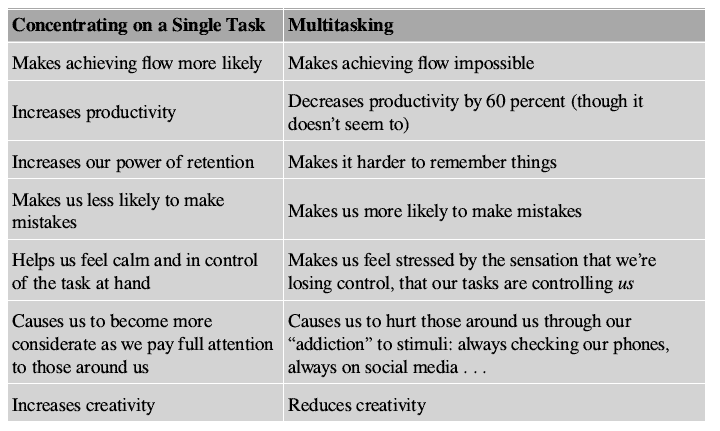
How to train your brain to focus on a single task
- Don’t look at any screen for the first hour you’re awake and the last hour before you go to sleep.
- Turn off your phone before you achieve flow. There is nothing more important than the task you have chosen to do during this time. If this seems too extreme, enable the “do not disturb” function so only the people closest to you can contact you in case of emergency.
- Designate one day of the week, perhaps a Saturday or Sunday, a day of technological “fasting,” making exceptions only for e-readers (without Wi-Fi) or MP3 players.
- Go to a café that doesn’t have Wi-Fi.
- Read and respond to e-mails only once or twice per day. Define those times clearly and stick to them.
- Try the Pomodoro Technique: Get yourself a kitchen timer (some are made to look like a Pomodoro or tomato) and commit to working on a single task as long as it’s running. The Pomodoro Technique recommends 25 minutes of work and 5 minutes of rest for each cycle, but you can also do 50 minutes of work and 10 minutes of rest. Find the pace that’s best for you; the most important thing is to be disciplined in completing each cycle.
- Start your work session with a ritual you enjoy and end it with a reward.
- Train your mind to return to the present when you find yourself getting distracted. Practice mindfulness or another form of meditation, go for a walk or a swim—whatever will help you get centred again.
- Work in a space where you will not be distracted. If you can’t do this at home, go to a library, a café, or, if your task involves playing the saxophone, a music studio. If you find that your surroundings continue to distract you, keep looking until you find the right place.
- Divide each activity into groups of related tasks, and assign each group its own place and time. For example, if you’re writing a magazine article, you could do research and take notes at home in the morning, write in the library in the afternoon, and edit on the couch at night.
- Bundle routine tasks—such as sending out invoices, making phone calls, and so on—and do them all at once.

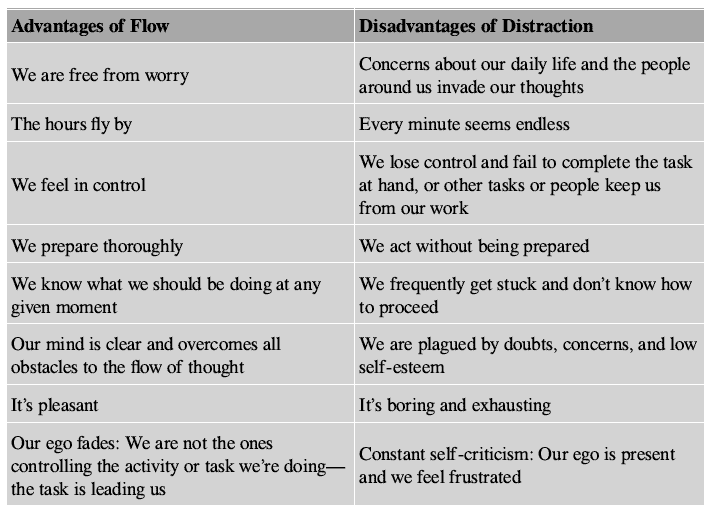
What do takumis (artisans), engineers, inventors, and otakus (fans of anime and manga) have in common? They all understand the importance of flowing with their ikigai at all times.
Microflow: Enjoying mundane tasks
Our ability to turn routine tasks into moments of microflow, into something we enjoy, is key to our being happy since we all have to do such tasks.
Even Bill Gates washes the dishes every night. He says he enjoys it—that it helps him relax and clear his mind and that he tries to do it a little better each day, following an established order or set of rules he’s made for himself: plates first, forks second, and so on. It’s one of his daily moments of microflow.
Instant Vacations: Getting there through meditation
Training the mind can get us to a place of flow more quickly. Meditation is one way to exercise our mental muscles. There are many types of meditation, but they all have the same objective: calming the mind, observing our thoughts and emotions, and centring our focus on a single object.
Meditation generates alpha and theta brain waves. For those experienced in meditation, these waves appear right away, while it might take a half hour for a beginner to experience them. These relaxing brain waves are the ones that are activated right before we fall asleep, as we lie in the sun, or right after taking a hot bath.
Humans as ritualistic beings
Rituals give us clear rules and objectives, which help us enter a state of flow. When we have only a big goal in front of us, we might feel lost or overwhelmed by it; rituals help us by giving us the process, the substeps, on the path to achieving a goal. When confronted with a big goal, try to break it down into parts and then attack each part one by one.
Focus on enjoying your daily rituals, using them as tools to enter a state of flow. Don’t worry about the outcome—it will come naturally. Happiness is in the doing, not in the result. As a rule of thumb, remind yourself: “Rituals over goals.”
Using flow to find your Ikigai, what activities do you do that enable you to enter flow?
What do all those activities have in common?
VI. Lessons From Japan’s Centenarians
Traditions and proverbs for happiness and longevity
Life philosophy, Ikigai and the secret to longevity from the centenarians.
- Don’t worry – The secret to life is not to worry. Open your heart to people with a smile on your face.
- Cultivate Good Habits – eating vegetables, waking up early, and keeping your body busy.
- Nurture your Friendships Every Day – getting together and talking with friends and family.
- Live an Unhurried Life – slow down; you live much longer if you are not in a hurry the whole time.
- Be Optimistic – positive energy and smiles.
VII. The Ikigai Diet
What the world’s longest-living people eat and drink
Okinawa’s Miracle Diet
- Locals eat a wide variety of foods, especially vegetables. They eat an average of eighteen different foods each day, a striking contrast to the nutritional poverty of our fast-food culture.
- They eat at least five servings of fruits and vegetables every day. The easiest way to check if there is enough variety on your table is to make sure you’re “eating the rainbow.”
- Grains are the foundation of their diet. Japanese people eat white rice every day, sometimes adding noodles.
- They rarely eat sugar, and if they do, it’s cane sugar.
Generally, they eat little salt and consume fewer calories than the rest of Japan. They also consume fish three times per week.
Hara Hachi Bu
This brings us back to the 80 percent rule, when you notice you’re almost full but could have a little more . . . just stop eating!
The key to staying healthy while consuming fewer calories is eating foods with a high nutritional value (especially “superfoods”) and avoiding those that add to our overall caloric intake but offer little to no nutritional value.
Another benefit of calorie restriction is that it reduces levels of IGF-1 (insulin-like growth factor 1) in the body. IGF-1 is a protein that plays a significant role in the ageing process; it seems that one of the reasons humans and animals age is an excess of this protein in their blood.
An alternative to following the 80 percent rule on a daily basis is to fast for one or two days each week. The 5:2 (or fasting) diet recommends two days of fasting (consuming fewer than five hundred calories) every week and eating normally on the other five days. Among its many benefits, fasting helps cleanse the digestive system and allows it to rest.
15 natural antioxidants found in the Okinawan diet
Antioxidants are molecules that slow the oxidation process in cells, neutralizing the free radicals that cause damage and accelerate ageing.
The antioxidant power of green tea, for example, is well-known and will be discussed later at greater length. Because they are rich in antioxidants and are eaten nearly every day in the region, these fifteen foods are considered keys to Okinawan vitality:
Tofu Miso Tuna Carrots Goya (bitter melon) Kombu (sea kelp) Cabbage Nori (seaweed) Onion Soy sprouts Hechima (cucumber-like gourd) Soybeans (boiled or raw) Sweet potato Peppers Sanpin-cha (jasmine tea)
Sanpin-cha: The Reigning Infusion in Okinawa
Okinawans drink more Sanpin-cha—a mix of green tea and jasmine flowers —than any other kind of tea.
In addition to all the antioxidant benefits of green tea, it boasts the benefits of jasmine, which include:
- Reducing the risk of heart attack
- Strengthening the immune system
- Helping relieve stress
- Lowering cholesterol.
Okinawans drink an average of three cups of Sanpin-cha every day.
It might be hard to find exactly the same blend in the West, but we can drink jasmine tea, or even a high-quality green tea, instead.
The Secrets of Green Tea
It offers meaningful health benefits such as:
- Controlling cholesterol
- Lowering blood sugar levels
- Improving circulation
- Protection against the flu (vitamin C)
- Promoting bone health (fluoride)
- Protection against certain bacterial infections
- Protection against UV damage
- Cleansing and diuretic effects
Drinking green or white tea every day can help us reduce the free radicals in our bodies, keeping us young longer.
The Antioxidant Canon, for Westerners In 2010, the UK’s Daily Mirror published a list of foods recommended by experts to combat ageing.
Among these foods readily available in the West are:
- Vegetables such as broccoli and chard, for their high concentration of water, minerals, and fibre.
- Oily fish such as salmon, mackerel, tuna, and sardines, for all the antioxidants in their fat.
- Fruits such as citrus, strawberries, and apricots; are excellent sources of vitamins and help eliminate toxins from the body.
- Berries such as blueberries and goji berries; they are rich in phytochemical antioxidants.
- Dried fruits, which contain vitamins and antioxidants and give you energy.
- Grains such as oats and wheat, which give you energy and contain minerals.
- Olive oil, for its antioxidant effects that show in your skin.
- Red wine, in moderation, for its antioxidant and vasodilatory properties.
- Foods that should be eliminated are refined sugar and grains, processed baked goods, and prepared foods, along with cow’s milk and all its derivatives.
Following this diet will help you feel younger and slow the process of premature ageing.
VIII. Gentle Movements, Longer Life
Exercises from the East that promote health and longevity
Studies from the Blue Zones suggest that the people who live longest are not the ones who do the most exercise but rather the ones who move the most.
Yoga
Yoga strives to unite body and mind in the same way, guiding us toward a healthy lifestyle in harmony with the world around us.
The main objectives of yoga are: To bring us closer to our (human) nature Mental and physical purification To bring us closer to the divine
Tai chi
Tai chi, which was also seen as a means of healing body and mind, would go on to be used more frequently to foster health and inner peace.
IX. Resilience and Wabi-Sabi
How to face life’s challenges without letting stress and worry age you
What is resilience?
One thing that everyone with a clearly defined ikigai has in common is that they pursue their passion no matter what. They never give up, even when the cards seem stacked against them, or they face one hurdle after another.
Resilience is our ability to deal with setbacks. The more resilient we are, the easier it will be to pick ourselves up and get back to what gives meaning to our lives.
Resilient people know how to stay focused on their objectives, on what matters, without giving in to discouragement. Their flexibility is the source of their strength: They know how to adapt to change and to reversals of fortune. They concentrate on the things they can control and don’t worry about those they can’t.
What’s the worst thing that could happen?
In order to keep their minds virtuous, the Stoics practised something like negative visualization: They imagined the worst thing that could happen in order to be prepared if certain privileges and pleasures were taken from them. To practice negative visualization, we have to reflect on negative events without worrying about them.
Meditating for healthier emotions
In addition to negative visualization and not giving in to negative emotions, another central tenet of Stoicism is knowing what we can control and what we can’t, as we see in the Serenity Prayer. Worrying about things that are beyond our control accomplishes nothing. We should have a clear sense of what we can change and what we can’t, which in turn will allow us to resist giving in to negative emotions.
In the words of Epictetus, “It’s not what happens to you, but how you react that matters.”
The here and now, and the impermanence of things
Another key to cultivating resilience is knowing in which time to live. Both Buddhism and Stoicism remind us that the present is all that exists, and it is the only thing we can control.
Instead of worrying about the past or the future, we should appreciate things just as they are in the moment, in the now. “The only moment in which you can be truly alive is the present moment,” observes the Buddhist monk Thich Nhat Hanh.
Wabi-sabi and ichi-go ichi-e
Ichi-go ichi-e teaches us to focus on the present and enjoy each moment that life brings us. This is why it is so important to find and pursue our ikigai.
Wabi-sabi teaches us to appreciate the beauty of imperfection as an opportunity for growth.
Beyond resilience: Antifragility
Antifragile: Things That Gain from Disorder, we use the word fragile to describe people, things, and organizations that are weakened when harmed, and the words robust and resilient for things that are able to withstand harm without weakening, but we don’t have a word for things that get stronger when harmed (up to a point).
In this case, Japanese construction companies are antifragile since they benefited enormously from the catastrophe (the tsunami).
Now let’s take a look at how we can apply this concept to our daily lives. How can we be more antifragile?
Step 1: Create redundancies
An example of this would be to create more than one stream of income, this way, you become less fragile if anything had to happen.
Step 2: Bet conservatively in certain areas and take many small risks in others.
The key to becoming antifragile is taking on small risks that might lead to great rewards without exposing ourselves to dangers that might sink us.
Diversifying your risks.
Step 3: Get rid of the things that make you fragile
What makes me fragile? Certain people, things, and habits generate losses for us and make us vulnerable. Who and what are they?
To build resilience in our lives, we shouldn’t fear adversity because each setback is an opportunity for growth. If we adopt an antifragile attitude, we’ll find a way to get stronger with every blow, refining our lifestyle and staying focused on our ikigai.
Conclusion
Our ikigai is different for all of us, but one thing we have in common is that we are all searching for meaning. When we spend our days feeling connected to what is meaningful to us, we live more fully; when we lose the connection, we feel despair.
Modern life estranges us more and more from our true nature, making it very easy for us to lead lives lacking in meaning. Powerful forces and incentives (money, power, attention, success) distract us on a daily basis; don’t let them take over your life. Our intuition and curiosity are very powerful internal compasses to help us connect with our ikigai.
Follow those things you enjoy, and get away from or change those you dislike. Be led by your curiosity, and keep busy by doing things that fill you with meaning and happiness. It doesn’t need to be a big thing: we might find meaning in being good parents or in helping our neighbours. There is no perfect strategy for connecting with our ikigai. But what we learned from the Okinawans is that we should not worry too much about finding it.
Life is not a problem to be solved. Just remember to have something that keeps you busy doing what you love while being surrounded by the people who love you.
The Ten Rules of Ikigai
We’ll conclude this journey with ten rules we’ve distilled from the wisdom of the long-living residents of Ogimi:
1. Stay active; don’t retire.
Those who give up the things they love doing and do well lose their purpose in life. That’s why it’s so important to keep doing things of value, making progress, bringing beauty or utility to others, helping out, and shaping the world around you, even after your “official” professional activity has ended.
2. Take it slow.
Being in a hurry is inversely proportional to the quality of life. As the old saying goes, “Walk slowly, and you’ll go far.” When we leave urgency behind, life and time take on new meaning.
3. Don’t fill your stomach.
Less is more when it comes to eating for long life, too. According to the 80 percent rule, in order to stay healthier longer, we should eat a little less than our hunger demands instead of stuffing ourselves.
4. Surround yourself with good friends.
Friends are the best medicine, there for confiding worries over a good chat, sharing stories that brighten your day, getting advice, having fun, dreaming . . . in other words, living.
5. Get in shape for your next birthday.
Water moves; it is at its best when it flows fresh and doesn’t stagnate. The body you move through life in needs a bit of daily maintenance to keep it running for a long time. Plus, exercise releases hormones that make us feel happy.
6. Smile.
A cheerful attitude is not only relaxing—it also helps make friends. It’s good to recognize the things that aren’t so great, but we should never forget what a privilege it is to be in the here and now in a world so full of possibilities.
7. Reconnect with nature.
Though most people live in cities these days, human beings are made to be part of the natural world. We should return to it often to recharge our batteries.
8. Give thanks.
To your ancestors, to nature, which provides you with the air you breathe and the food you eat, to your friends and family, to everything that brightens your days and makes you feel lucky to be alive. Spend a moment every day giving thanks, and you’ll watch your stockpile of happiness grow.
9. Live in the moment.
Stop regretting the past and fearing the future. Today is all you have. Make the most of it. Make it worth remembering.
10. Follow your ikigai.
There is a passion inside you, a unique talent that gives meaning to your days and drives you to share the best of yourself until the very end. If you don’t know what your ikigai is yet, as Viktor Frankl says, your mission is to discover it.